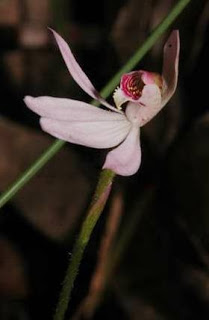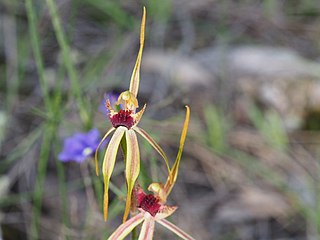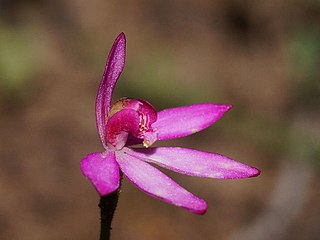
Caladenia carnea, commonly known as pink fingers, is a plant in the orchid family Orchidaceae and is endemic to eastern and south-eastern Australia, including Tasmania. It has a single thin, green leaf and one to five white or pink flowers with red stripes and two rows of yellow-tipped "calli" on their labellum.

Caladenia picta, commonly known as painted fingers, is a species of orchid endemic to New South Wales. It has a single, sparsely hairy leaf and a single white or pink flower with a greenish-white back. Unlike many other caladenias, it flowers in autumn.

Caladenia fuscata, commonly known as dusky fingers, is a plant in the orchid family Orchidaceae and is endemic to eastern and south-eastern Australia, including Tasmania. It is a small ground orchid found in eucalyptus woodland and which flowers in September and October.

Caladenia gracilis, commonly known as musky caps or musky caladenia, is a plant in the orchid family Orchidaceae and is endemic to eastern and south-eastern Australia, including Tasmania. It is a ground orchid with a single leaf and up to six flowers which are dark-coloured on the back and white on the front, sometimes tinged with pink and with a strong musky or soapy odour. The species is also known as Caladenia moschata in Victoria.

Caladenia catenata, commonly known as white caladenia, white fingers and lady's fingers, is a plant in the orchid family Orchidaceae and is endemic to New South Wales, Queensland and Victoria. It is a ground orchid with a single hairy leaf and one or two white, sometimes pink flowers on a thin, sparsely-hairy stem. It is similar to Caladenia carnea but lacks the red and white bars on the labellum of that species.

Caladenia clarkiae, commonly known as pink caps, is a plant in the orchid family Orchidaceae and is endemic to south-eastern Australia. It is a ground orchid which grows singly or in small groups in Victoria and New South Wales. It has a single leaf and usually one or two white to pale pink flowers with darker pink tips.

Caladenia cucullata, commonly known as the hooded caladenia, is a plant in the orchid family Orchidaceae and is endemic to south-eastern Australia. It is a ground orchid with a single, sparsely hairy leaf, and up to seven white flowers with a purplish labellum.

Caladenia curtisepala, commonly known as short-hooded fingers, is a plant in the orchid family Orchidaceae and is endemic to south-eastern Australia. It is a ground orchid with a single hairy leaf, and a single white to cream-coloured flower with a white labellum with red bands.

Caladenia dimorpha, commonly known as spicy caps, is a plant in the orchid family Orchidaceae and is endemic to New South Wales. It is an uncommon ground orchid with a single sparsely hairy leaf, and up to three white flowers which often have pinkish markings.

Caladenia hillmanii, commonly known as purple-heart fingers, is a plant in the orchid family Orchidaceae and is endemic to New South Wales. It is a ground orchid with a single leaf and one or two bright pink flowers with a reddish-purple labellum with darker bars.

Caladenia longiclavata, commonly known as the clubbed spider orchid is a species of plant in the orchid family, Orchidaceae and is endemic to the south-west of Western Australia. It is a widespread and common orchid with a single, hairy leaf and one or two greenish-yellow, white and red flowers and which grows in the area between Perth and Albany.

Caladenia mentiens, commonly known as lesser fingers, is a species of orchid endemic to south-eastern Australia which grows singly, or in small, loose groups. It has a single, sparsely hairy, erect, linear leaf and a single whitish or pinkish coloured flower with a darker back and a cream-coloured labellum.

Caladenia ornata, commonly known as ornate pink fingers is a species of orchid endemic to Victoria. It has a single leaf and one or two bright pink flowers with greenish-pink backs, and a dark pink labellum with dark red bars.
Caladenia osmera is a plant in the orchid family Orchidaceae and is endemic to south-eastern Australia. It is a ground orchid with a single leaf and one or two greenish-cream flowers with pink stripes and which has a sharp odour resembling burnt plastic.

Caladenia parva is a plant in the orchid family Orchidaceae and is endemic to south-eastern Australia. It is a ground orchid with a single leaf and one or two green flowers with red stripes along the sepals and petals.
Caladenia patersonii is a plant in the orchid family Orchidaceae and is native to Victoria and Tasmania. It is a ground orchid with a single hairy leaf and one or two creamy-white, yellowish or pink flowers.
Caladenia quadrifaria, commonly known as the large pink fingers orchid is a plant in the orchid family Orchidaceae and is endemic to New South Wales. It is a ground orchid with a single, sparsely hairy leaf and up to three pale to bright pink flowers.

Caladenia praecox, commonly known as early caladenia or early caps is a plant in the orchid family Orchidaceae and is endemic to south-eastern Australia. It is a ground orchid with a single leaf and up to four white flowers which are often tinged with green or pink.

Caladenia prolata, commonly known as long-leaf fingers or white fingers is a plant in the orchid family Orchidaceae and is endemic to southern Australia. It is a ground orchid with a single leaf and one or two dull white flowers which are greenish with red stripes on the back.

Caladenia valida, commonly known as the robust spider orchid, is a plant in the orchid family Orchidaceae and is endemic to south-eastern continental Australia. It is a ground orchid with a single sparsely hairy leaf and up to three white to cream-coloured flowers which sometimes have red streaks. It is similar to Caladenia reticulata but is large and taller with more stiffly spreading lateral sepals and petals.

















